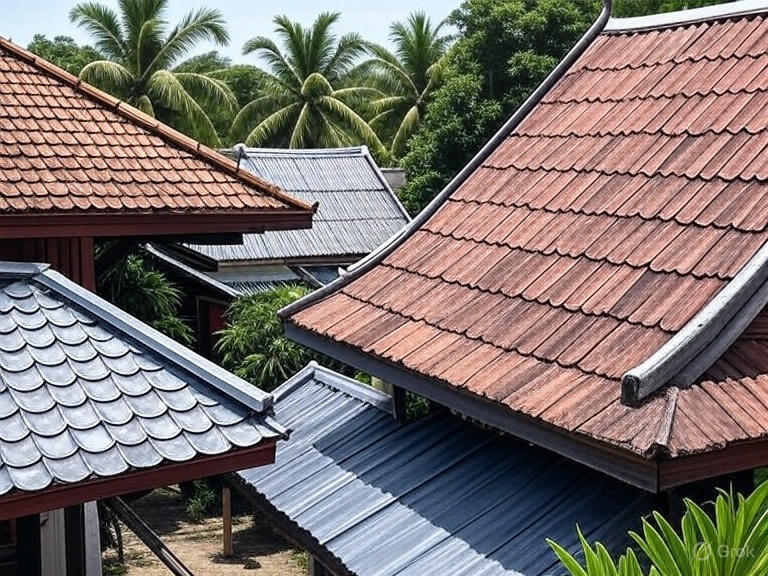
October 01, 2025 - Zed van der Vyver
Introduction to Roofing in Thailand
Roofing is a critical part of any home in Thailand, where the tropical climate brings heavy monsoons, intense sunlight, and high humidity. It’s not just a cover—it’s your first line of defense against the elements. This blog will explain why roofing matters in Thailand, the different types for various needs, how they’re made, and what they might cost. No building expertise required—just clear info to help you understand this essential component of your home!
Why Roofing Is Essential in Thailand
A roof protects your home from rain, heat, and wind, which are constant challenges in Thailand. During the monsoon season, especially in places like Chiang Mai or Ayutthaya, heavy downpours can flood homes without a sturdy roof. It also shields against the scorching sun, keeping interiors cooler in Bangkok’s urban heat or Phuket’s coastal areas. Beyond protection, roofs can define a home’s style—think of traditional Thai temple roofs or modern tiled designs. In flood-prone or windy regions, a well-made roof ensures safety and comfort year-round.
Types of Roofing for Different Scenarios in Thailand
Roofs come in various materials and designs, and the best one depends on your location and needs. Here’s a look at common types in Thailand and where they fit best:
Terracotta Tile Roofs
Use: Traditional homes or rural areas.
Why: Made from local clay, they’re durable, cool, and reflect Thailand’s heritage. They handle rain well but need slopes for drainage.
Example Scenario: A village house in Isaan.
Metal Roofs
Use: Modern homes or warehouses.
Why: Lightweight and rust-resistant if coated, they’re quick to install and good for flat or sloped designs. They reflect heat.
Example Scenario: A factory in Chonburi.
Concrete Tile Roofs
Use: Urban homes or flood zones.
Why: Heavy and waterproof, they withstand heavy rain and provide insulation. Often used with concrete frames.
Example Scenario: A house in Nonthaburi.
Thatch Roofs
Use: Eco-friendly or resort homes.
Why: Made from palm leaves or grass, they’re traditional and breathable but need frequent upkeep in humid climates.
Example Scenario: A resort in Krabi.
Your choice depends on your climate, budget, and home style. Thai brands like SCG or local artisans provide options suited to the region.
How Roofs Are Made in Thailand
Roofing in Thailand is designed to endure the tropical climate while meeting aesthetic and structural needs. Here’s a general overview of the process:
- Design and Framing: A sloped or flat frame is built from wood or steel, tailored to local weather—like steep slopes for monsoon runoff.
- Material Prep: Terracotta tiles are molded from clay, dried, and fired. Metal sheets are cut and coated. Concrete tiles are cast in molds, and thatch is harvested and bundled.
- Installation: Tiles are laid with overlapping edges and secured with mortar or nails. Metal sheets are screwed onto the frame, often with insulation underneath. Thatch is tied in layers, starting from the bottom.
- Waterproofing: Membranes or sealants are applied, especially on metal or concrete, to prevent leaks during Thailand’s rains.
- Finishing: Gutters and downspouts are added for drainage. Terracotta might be glazed, and metal can be painted for extra protection.
Rural areas often feature handmade thatch or terracotta, while factories in Bangkok produce metal and concrete tiles for urban projects.
Cost Comparison of Roofing in Thailand
Roofing costs in Thailand vary by material, area, and installation effort. Here’s a breakdown (in Thai Baht per square meter, as of October 2025):
| Roof Type | Cost (THB per sqm) | Typical Use | Notes |
|---|---|---|---|
| Terracotta Tile | 300–800 | Traditional homes | Low cost; labor-intensive installation. |
| Metal Roof | 400–1,200 | Modern homes | Quick install; coating adds cost. |
| Concrete Tile | 500–1,500 | Urban builds | Heavy; includes frame support. |
| Thatch Roof | 200–600 | Rural resorts | Cheap initially; frequent upkeep. |
Example Calculation: A 50 sqm terracotta roof might cost 15,000–40,000 THB, while a metal roof of the same size could be 20,000–60,000 THB. Installation adds 200–500 THB per sqm, higher in coastal areas like Phuket. Prices are up 10–20% since 2020 due to material price hikes.
Final Thoughts
Roofing in Thailand is a vital shield against heat, rain, and wind, while also shaping your home’s character. Whether you choose terracotta for a traditional look or metal for a modern build, there’s a type for every need. Consider your location, weather challenges, and budget, and consult local suppliers for the best options. A good roof is the foundation of a safe, comfortable home. Got questions? Leave a comment—we’re here to help!
